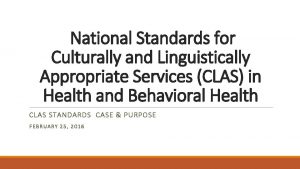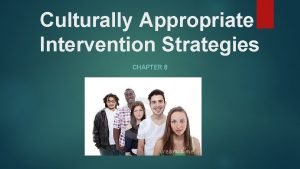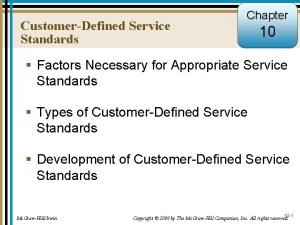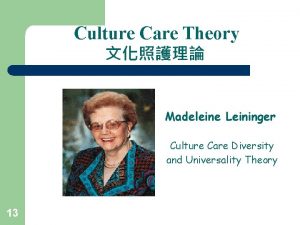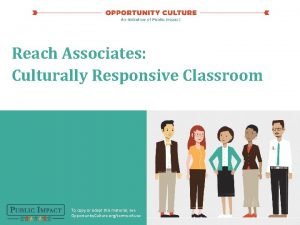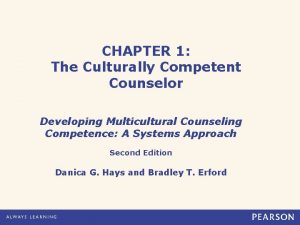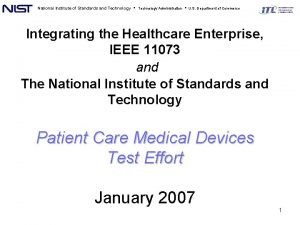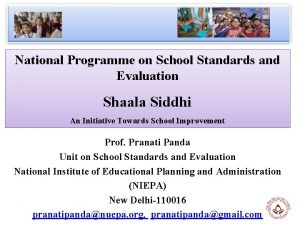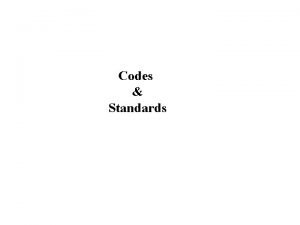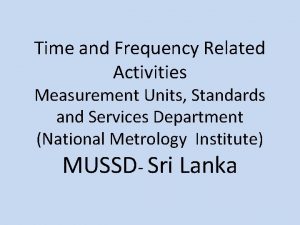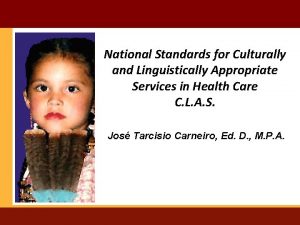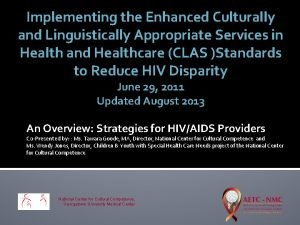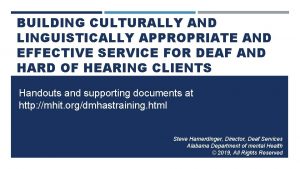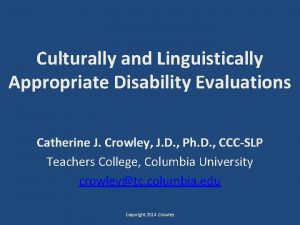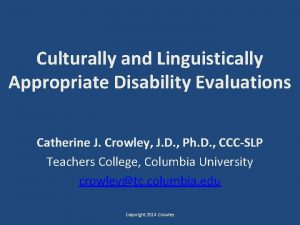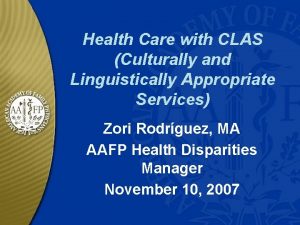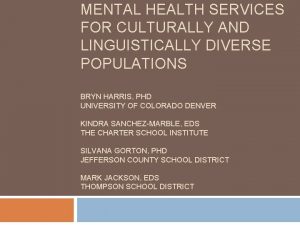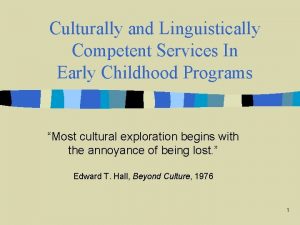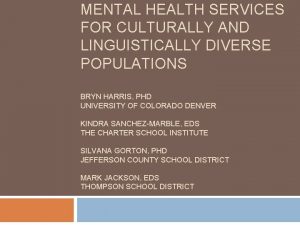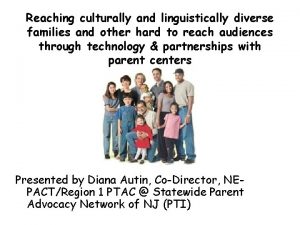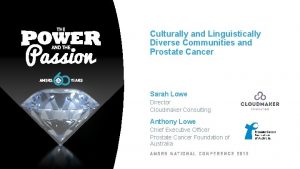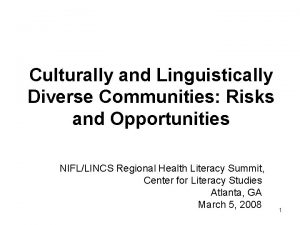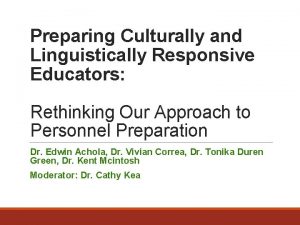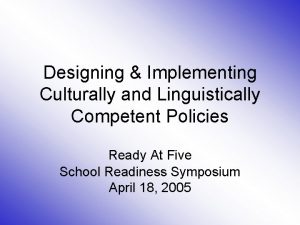National Standards for Culturally and Linguistically Appropriate Services






















- Slides: 22

National Standards for Culturally and Linguistically Appropriate Services (CLAS) in Behavioral Health Intersection of CLAS Standards and Community Corrections

Agenda • • History Business Case Purpose/How are they applied The CLAS Standards 1 – 15 Application in Behavioral Health Care Thoughts on intersection with CC Resources Q & A

CLAS Standards History • U. S. Dept. of Health and Human Services, Office of Minority Health began the work in 2000 with the following partner organizations: . • Joint Commission Members; HHS, Office of Minority Health; U. S. Dept. of Justice; Office of Civils Rights; Health and Hospitals, Public Health Framework; CDC Action Steps for Prevention Standards; SAMHSA-HRSA Children, Families, Consumer Health Information Coordination, Centers for Medicaid and Medicare Services; Nat’l institute of Health (NIH); Indian Health Services; Administration for Preparedness and Response; Nat’l Admin. For Community Planning and Living, including Transportation and Immigration.

CLAS Standards History • Original framework to serve diverse communities. • Expanded to address cultural domains for the purpose of eliminating long standing health disparities • In 2010, Office of Minority Health launched the initiative nationally. • Revised version - April, 2013

2013 Revision ELEMENTS 2010 CLAS STANDARDS Culture Limited to race, ethnic and Revised to include broader language groups elements of difference – geographical, religious/spiritual, biological, sociological Identified focus Health care organizations Health outcomes and health care organizations Health Definition was implied Definition detailed to include, mental health, emotional, social and spiritual well being. Recipients Patients/Consumers Individuals and groups 2013 CLAS STANDARDS

Case/Purpose • Advance behavioral health equity by ensuring for culturally appropriate interventions. • Eliminate long standing health disparities • Improve quality of health services • Expand Scope of Service Delivery • Meet accreditation, legislative and regulatory mandates. • Manage risk • Positions agency to capture market share in a service area.

Principal Theme Standard 1 Provide effective, equitable, understandable and respectful quality care and services that are responsive to diverse cultural health beliefs and practices, preferred languages, health literacy and other communication needs. USDHHS. The Office of Minority Health. National Standards on Culturally and Linguistically Appropriate Services (CLAS)

THEME 2: Governance, Leadership and Workforce - Standard 2 -4 Standard 2 - Advance and sustain organizational governance and leadership that promotes CLAS and health equity through policy, practices and allocated resources. 3 - Recruit, promote and support a culturally and linguistically diverse governance, leadership and workforce that are responsive to the population in service area. 4 - Educate and train governance, leadership and workforce in culturally and linguistically appropriate policies and practices on an ongoing basis. Goal 2 - Cultural competent in governance and leadership; recruit train and support diverse representation on boards. 3 – Workforce/system that is equipped with well trained, competent workforce with the supports needed to develop and retain them. 4 – Ensure for a workforce and governance that is educated on the role of culturally responsive , patient centered care. USDHHS. The Office of Minority Health. National Standards on Culturally and Linguistically Appropriate Services (CLAS)

THEME 3: Communication & Language Assistance - Standard 5 - 8 Standard Goal 5 - Offer language assistance to individuals who have limited English proficiency and/or other communication needs at no cost to them, to facilitate timely access to all health care, services and supports. 6 - Inform all individuals of the availability of language assistance services clearly and in their preferred language , both verbally and in writing. 5 - Ensure clients with LEP have access to information, programs and services at a level equal to those that are English proficient. 6 – Engage community and provide information on capacity and commitment to provide communication, language assistance in the individuals preferred language, including ASL. USDHHS. The Office of Minority Health. National Standards on Culturally and Linguistically Appropriate Services (CLAS)

THEME 3: Communication & Language Assistance - Standards 5 - 8 Standard Goal 7 - Ensure the competence of individuals that provide language assistance, recognize that use of untrained individuals and/or minors as interpreters should be avoided. 8 - Provide easy to understand print and multi-media materials and signage in the languages commonly used by the populations in the service area. 7 - Ensure interpretation services are high quality, and have been professionally vetted. Language assistance is meaningful, respectful and accurate. 8 - Communication with signage, forms, procedures, protocols is relevant, understandable. – Ensures client/community population is known by provider agencies. USDHHS. The Office of Minority Health. National Standards on Culturally and Linguistically Appropriate Services (CLAS)

THEME 4: Engagement, Continuous Improvement, & Accountability Standards 9 – 15 Standard 9 - Establish culturally and linguistically appropriate goals, policies and management accountability and infuse them throughout the organization’s planning and operations 10 - Conduct ongoing assessments of the organization’s CLAS Standards related activities and integrate –CLAS- related measures into measurement and continuous quality improvement activities. 11 - Collect and maintain accurate and reliable demographic data in order monitor and evaluate the impact of CLAS on health equity and outcomes to inform service delivery. Goal 9 – Advance and build sustainability for governance and administration that promotes CLAS through its infrastructures. 10 - Assess performance, monitor progress of implementing the CLAS Standards, collect current and accurate compliance data to support quality improvement activity. 11 – knowledgeable about population/community within the service area, monitor the families, children, youth, young adult exact needs, ensure allocation of resources, improve service planning care coordination, ensure services are delivered equitably. USDHHS. The Office of Minority Health. National Standards on Culturally and Linguistically Appropriate Services (CLAS)

THEME 4: Engagement, Continuous Improvement, & Accountability Standards 9 – 15 Standards Goal 12 - Conduct regular assessments of community health assets and needs; use the results to plan and implement services that respond to the cultural and linguistic diversity of populations in the service area. 13 - Partner with the community to design, implement and evaluate policies, practices and services, in order to ensure cultural and linguistic appropriateness. 12 – Accurate data about needs of the identified population, barriers to service, Updated data for use indecision making at regular intervals. 13 - Develop and implement culturally sensitive, cost effective, services that are guided, informed and supported by the community. USDHHS. The Office of MInority Helath. NAtional Standards on CUlturally and Linguistically Appropriate Services (CLAS)

THEME 3: Engagement, Continuous Improvement, & Accountability Standards 9 – 15 Standards 14 - Create conflict and grievance resolution processes that are culturally and linguistically appropriate in order to identify, prevent, and resolve conflicts or complaints. 15 - Communicate the organization’s progress in implementing and sustaining CLAS Standards to all stakeholders, constituents and the general public. Goal 14 - Facilitate transparent open dialogue and feedback between consumers and agencies/ identify/ respond to cross cultural needs, meet Federal, State regulations on grievance, discrimination procedures. 15 – Engage with community and convey progress, gain input from organizations , on approaches to implementing the CLAS Standards, meet reporting requirements, accountability in meeting health care objectives USDHHS. The Office of MInority Helath. NAtional Standards on CUlturally and Linguistically Appropriate Services (CLAS)

Behavioral Health Continuum of Care Model. Where does Criminal Justice fit?

Definitions • Cultural Competence – ability of an individual or organization to interact effectively with people of different cultures. To produce positive change, prevention practitioners must understand the cultural context of their target community, and have the willingness and skills to work within this context. This means drawing community based values, traditions, and customs, and working with knowledgeable persons of and from the community to plan, implement, and evaluate prevention activities. (SAMHSA, U. S. Department of Health and Human Services. Office of Minority Health) • Diversity - the quality of being different or unique at the individual or group level. Diversity takes into account, but is not limited to race, religion, sexual orientation, gender identity, language, ethnicity, ability, physical and mental health status, sex, socioeconomic status, and national origin. (MHRSB 2016 Diversity Report) • Health equity - attainment of the highest level of health for all people. Achieving health equity requires valuing everyone equally with focused and ongoing societal efforts to address voidable inequalities, historical and contemporary injustices, and the elimination of health and health care disparities. (MHRSB 2016 Diversity Report)

Definitions Linguistic Competence – the capacity of an organization and its personnel to communicate effectively and convey information in a manner that is easily understood by diverse audiences including persons of limited English proficiency, those who are not iterate or have low literacy skills, and individuals with disabilities. The organization must have policy, structures, practices, procedures and dedicated resources t 0 support this capacity. (Tawara D. Goode and Wendy Jones, 8/00, revised 8/03. 6/03 National Center for Cultural Competence. Center for Child and Human Development, Georgetown University)

Factors/Discussion • Describe the factors that support and promote the implementation of these standards in Organizations/ Agencies utilized within your system. • Describe the factors that function as barriers to the implementation of these standards in Organizations/ Agencies utilized within your system. • What is the value of these standards to your system?

Thoughts on a culturally competent system…. Must be seen and felt at every level of an organization or system. Progressive. Leadership and governance must be a part of the transition. Need accountability measures. System and the workforce need training and development to make the transition.

Mental Health and Recovery Services Board of Lucas County Strategy • Formed Workgroup - Community leaders and stakeholders, Consumers, Board staff • Developed a work plan with recommendations • Presented to Board of trustees • Developed a positon to lead the efforts to transform system of care based on detailed Board approved recommendations. • First step - secure a self assessment tool • Implement the tool • Use data in decision making USDHHS. The Office of MInority Helath. NAtional Standards on CUlturally and Linguistically Appropriate Services (CLAS)

Mental Health and Recovery Services Board of Lucas County Strategies: Behavioral Health & Criminal Justice (BHCJ) - Developed a strategic focus on how the criminal justice and behavioral health system connect to meet the needs of clients in the jail system with urgent and/or chronic mental health and addiction treatment issues. • Through partnership on the Toledo/Lucas County Criminal Justice Coordinating Council, the collective goals established are to reduce the inappropriate or unnecessary jail time and increase the use of jail alternatives, provide earlier opportunities for alternatives to prosecution; and enhance the amount and quality of client advocacy within the system. • Supporting MHRSB actions that were implemented in FY 18 include: • – establishment of an Ad-Hoc Behavioral Health Criminal Justice Committee that provides leadership to drive the BHCJ strategies and establish accountability measures; – provided funds for a full time BHCJ Coordinator position to enhance the collaboration between the two organizations and to implement its strategies and collect data on the success of the program. Opportunity Project - The Opportunity Project is a key component of the BHCJ, and is operated by the Toledo Legal Aid Society. The goal is the effective and efficient representation of clients with addiction and/or mental health issues who are involved in the criminal justice system. MHRSB provide funds to employ two case managers to serve clients involved in the project. Planning and decision making continue to better address the needs of the population.

Resources • https: //www. thinkculturalhealth. hhs. gov/asse ts/pdfs/Enhanced. CLASStandards. Blueprint. pdf • Implementing the National CLAS Standards https: //www. thinkculturalhealth. hhs. gov/assets /pdfs/CLASCrosswalk. pdf

Presenter Contact Information Delores Williams Director Health Equity Mental Health and Recovery Services Board of Lucas County(MHRSB) dwilliams@lcmhrsb. oh. gov 419 -213 -4600
 National culturally and linguistically appropriate services
National culturally and linguistically appropriate services Working with culturally and linguistically diverse families
Working with culturally and linguistically diverse families Culturally responsive vs culturally relevant
Culturally responsive vs culturally relevant Culturally appropriate intervention strategies
Culturally appropriate intervention strategies Culturally responsive teaching and the brain powerpoint
Culturally responsive teaching and the brain powerpoint Factors necessary for service standards are
Factors necessary for service standards are Hard and soft service standards examples
Hard and soft service standards examples Culturally deprived meaning
Culturally deprived meaning Vdoe culturally responsive teaching
Vdoe culturally responsive teaching Giger and davidhizar transcultural assessment model
Giger and davidhizar transcultural assessment model Theory of culture care diversity and universality
Theory of culture care diversity and universality Culturally responsive teaching in music education
Culturally responsive teaching in music education Classroom
Classroom Reach associates
Reach associates Culturally competent counselor
Culturally competent counselor Culturally relevant pedagogy
Culturally relevant pedagogy National institute of standards and technology
National institute of standards and technology How to write mission statement in shaala siddhi
How to write mission statement in shaala siddhi Code standards and practices 2 level 1 lesson 5 services
Code standards and practices 2 level 1 lesson 5 services Mussd
Mussd National unification and the national state
National unification and the national state Formuö
Formuö Novell typiska drag
Novell typiska drag
